PORSCHE CAYNNE TURBO 2005 1.G Owners Manual
Manufacturer: PORSCHE, Model Year: 2005, Model line: CAYENNE TURBO, Model: PORSCHE CAYENNE TURBO 2005 1.GPages: 369, PDF Size: 3.17 MB
Page 311 of 369

Practical Tips, Minor Repairs
311
Fuse assignment – fuse box in engine compartmentNote
Use the plastic grippers from the fuse boxes in the dashboard to replace the fuses.No. Designation Rating in A
1
Fan
60
2Fan30
3
Secondary air pump
40
4 Secondary air pump40
567
Fuel injectors, ignition coils
20
8 Fuel injectors, ignition coils20
9
Engine control units
30
10 Engine components: radiator fans, afterrun pump, carbon canister valve, AC pressure sensor, tank leakage diagnosis 10
11
Engine components
15
12 E-box relay, secondary air pumps, afterrun pump relay5
13
Fuel pump
15
14 Fuel pump15
15
Engine control unit, fuel pump
10
16 Vacuum pump30
17
Oxygen sensors
15
18 Oxygen sensors7,5
Page 312 of 369
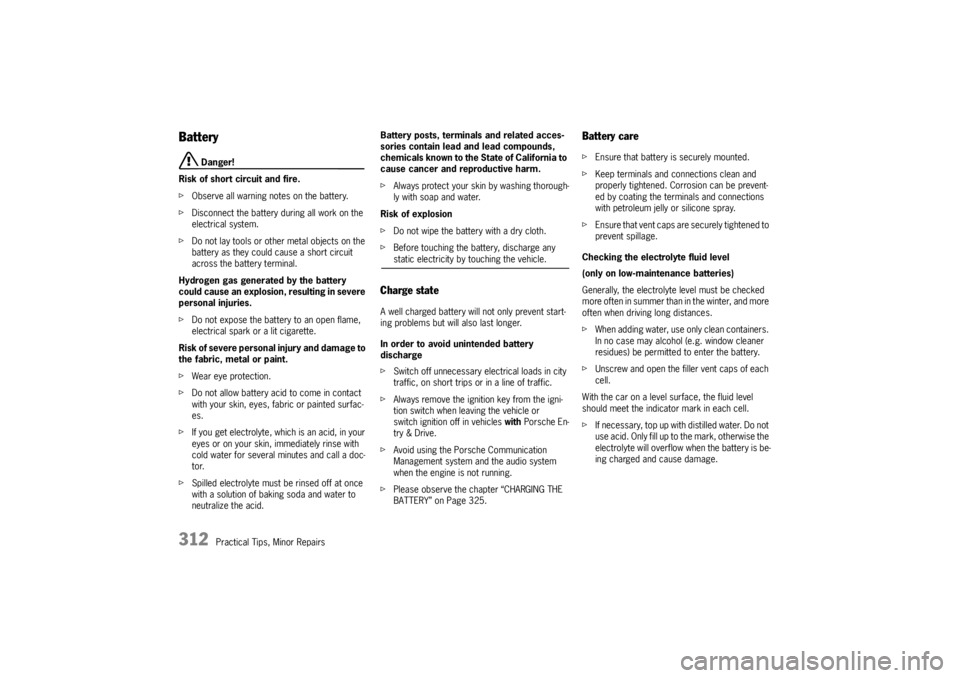
312
Practical Tips, Minor Repairs
Battery
Danger!
Risk of short circuit and fire.
fObserve all warning notes on the battery.
fDisconnect the battery during all work on the
electrical system.
fDo not lay tools or other metal objects on the
battery as they could cause a short circuit
across the battery terminal.
Hydrogen gas generated by the battery
could cause an explosion, resulting in severe
personal injuries.
fDo not expose the battery to an open flame,
electrical spark or a lit cigarette.
Risk of severe personal injury and damage to
the fabric, metal or paint.
fWear eye protection.
fDo not allow battery acid to come in contact
with your skin, eyes, fabric or painted surfac-
es.
fIf you get electrolyte, which is an acid, in your
eyes or on your skin, immediately rinse with
cold water for several minutes and call a doc-
tor.
fSpilled electrolyte must be rinsed off at once
with a solution of baking soda and water to
neutralize the acid.Battery posts, terminals and related acces-
sories contain lead and lead compounds,
chemicals known to the State of California to
cause cancer and reproductive harm.
fAlways protect your skin by washing thorough-
ly with soap and water.
Risk of explosion
fDo not wipe the battery with a dry cloth.
fBefore touching the battery, discharge any
static electricity by touching the vehicle.
Charge stateA well charged battery will not only prevent start-
ing problems but will also last longer.
In order to avoid unintended battery
discharge
fSwitch off unnecessary electrical loads in city
traffic, on short trips or in a line of traffic.
fAlways remove the ignition key from the igni-
tion switch when leaving the vehicle or
switch ignition off in vehicles with Porsche En-
try & Drive.
fAvoid using the Porsche Communication
Management system and the audio system
when the engine is not running.
fPlease observe the chapter “CHARGING THE
BATTERY” on Page 325.
Battery carefEnsure that battery is securely mounted.
fKeep terminals and connections clean and
properly tightened. Corrosion can be prevent-
ed by coating the terminals and connections
with petroleum jelly or silicone spray.
fEnsure that vent caps are securely tightened to
prevent spillage.
Checking the electrolyte fluid level
(only on low-maintenance batteries)
Generally, the electrolyte level must be checked
more often in summer than in the winter, and more
often when driving long distances.
fWhen adding water, use only clean containers.
In no case may alcohol (e.g. window cleaner
residues) be permitted to enter the battery.
fUnscrew and open the filler vent caps of each
cell.
With the car on a level surface, the fluid level
should meet the indicator mark in each cell.
fIf necessary, top up with distilled water. Do not
use acid. Only fill up to the mark, otherwise the
electrolyte will overflow when the battery is be-
ing charged and cause damage.
Page 313 of 369

Practical Tips, Minor Repairs
313
Winter operationDuring the winter months, battery capacity tends
to decrease as temperatures drop. Additionally,
more power is consumed while starting, and the
headlights, heater, rear window defogger, etc.,
are used more frequently.
Let your Porsche dealer test the battery's capaci-
ty before winter sets in.Vehicle storageIf the car stands for long periods in the garage or
workshop, the doors and lids should be closed.
fRemove the ignition key and, if necessary, dis-
connect the battery.
Notes on operation
fWhen the battery is disconnected, the alarm
system ceases to function.
If the vehicle was locked before the battery
was disconnected, the alarm will be triggered
when the battery is reconnected.
To deactivate the alarm system:
fLock the vehicle and unlock it again.Maintenance note
Even if you put your vehicle out of operation, the
battery still discharges.
The battery will discharge more quickly if your ve-
hicle is not driven on a daily basis over a distance
of several miles. The more often you drive your ve-
hicle, and the longer the distance driven on each
trip, the more opportunity the vehicle‘s charging
system will have to recharge the batteries.
fTo preserve its efficiency, charge the battery
about every 6 weeks.
fCheck the battery acid level and top off with
distilled water if necessary.
fStore a battery that has been removed in a
dark, cool place, but not subject to freezing.
Putting vehicle into operationAfter the battery is connected or charged, the
PSM warning light lights up on the instrument pan-
el and a message appears on the multi-purpose
display of the instrument panel to indicate a fault.
This fault can be remedied with a few simple
steps:
1. Start the engine.
To do this, turn the ignition key or the control
unit (on vehicles that have Porsche Entry &
Drive) to ignition lock position 2 twice.2. Perform a few steering movements and drive
a short distance in a straight line until the PSM
warning light goes out and the message is
erased from the memory of the multi-purpose
display of the instrument panel.
3. If the warnings does not go out, then:
Drive carefully to the nearest authorized
Porsche dealer.
Have the fault remedied by an authorized
Porsche dealer.
4. After the warnings disappear:
Stop the vehicle in a suitable place.
5. Perform adaptation of the power windows:
Please observe the chapter “STORING FINAL
POSITION OF THE DOOR WINDOWS” on
Page 31.
6. On vehicles with tire pressure monitoring sys-
tem:
Please observe the chapter “TIRE PRESSURE
MONITORING SYSTEM LEARNING PROCESS”
on Page 87.
Page 314 of 369

314
Practical Tips, Minor Repairs
Replacing the batteryThe service life of the battery is subject to normal
wear; it depends greatly on care, climatic condi-
tions, and driving conditions (distances, loads).
fOnly use an original Porsche battery, with the
correct part number, as a replacement. Only
this battery meets the specific requirements of
the vehicle.
fPlease observe the disposal instructions for
batteries.
Battery chargingAutomotive batteries loose their efficiency when
not in use. The charge available in your battery can
be measured with a battery hydrometer. We rec-
ommend that the battery voltage be tested by
your Porsche dealer who has the appropriate
equipment.
If the car is not driven for prolonged periods, the
battery must be charged at least every 6 weeks.
A discharged battery allows rapid formation of sul-
fates, leading to premature deterioration of the
plates.
Danger!
Hydrogen gas generated by the battery
could cause an explosion, resulting in severe
personal injuries.
fCharge battery in a well ventilated area.
fNever charge a frozen battery. It may explode
because of gas trapped in the ice. Allow a fro-
zen battery to thaw out first.
fIf you get electrolyte, which is an acid, in your
eyes or on your skin, immediately rinse with
cold water for several minutes and call a doc-tor.
Note
Your authorized Porsche dealer will be pleased to
advise you about a suitable charger.Slow battery charging
1. Pay attention to all warnings and follow instruc-
tions that come with your battery charger.
2. When charging, ensure adequate ventilation.
3. Remove battery.
Please observe the chapter “REMOVING AND
INSTALLING BATTERY” on Page 315.
4. All vent caps should be open.The fluid level
should meet the indicator mark in each cell.
5. Ensure that charger is switched off – danger of
short circuit!
6. Connect charger cables.Charger cables must
be connected POSITIVE (+) to POSITIVE (+)
and NEGATIVE (–) to NEGATIVE (–).
7. Switch on charger. Normally, a battery should
be charged at no more than 10 percent of its
rated capacity. Rated capacity of the battery in
your vehicle is listed on the battery housing.
8. After charging, turn off charger and disconnect
charger cables.
9. Tighten the vent caps and reinstall battery.
Please observe the chapter “REMOVING AND
INSTALLING BATTERY” on Page 315.
Page 315 of 369
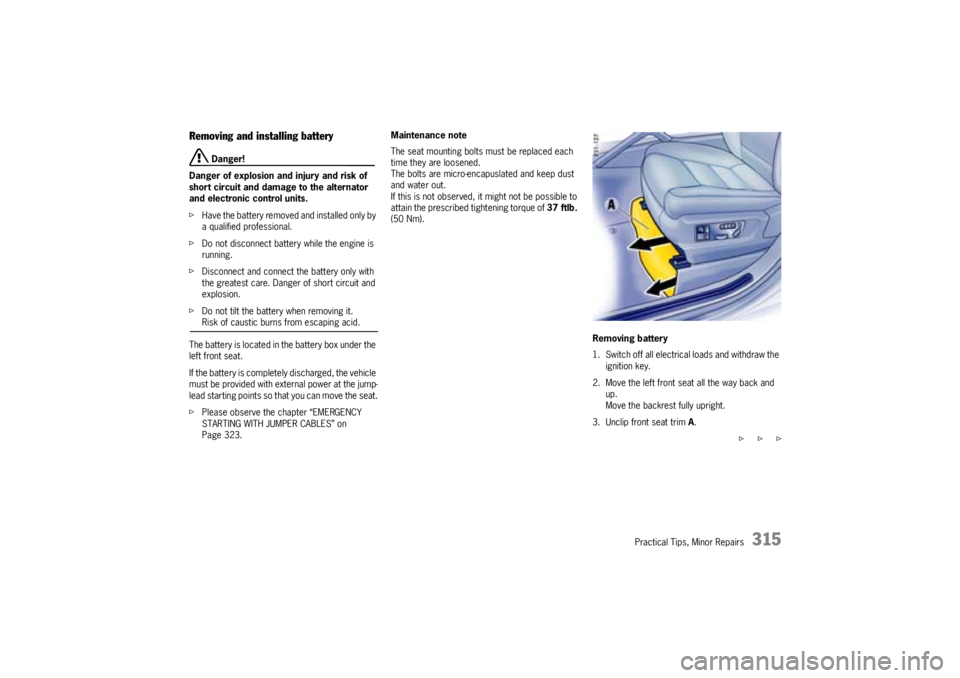
Practical Tips, Minor Repairs
315
Removing and installing battery
Danger!
Danger of explosion and injury and risk of
short circuit and damage to the alternator
and electronic control units.
fHave the battery removed and installed only by
a qualified professional.
fDo not disconnect battery while the engine is
running.
fDisconnect and connect the battery only with
the greatest care. Danger of short circuit and
explosion.
fDo not tilt the battery when removing it.Risk of caustic burns from escaping acid.
The battery is located in the battery box under the
left front seat.
If the battery is completely discharged, the vehicle
must be provided with external power at the jump-
lead starting points so that you can move the seat.
fPlease observe the chapter “EMERGENCY
STARTING WITH JUMPER CABLES” on
Page 323.Maintenance note
The seat mounting bolts must be replaced each
time they are loosened.
The bolts are micro-encapuslated and keep dust
and water out.
If this is not observed, it might not be possible to
attain the prescribed tightening torque of 37 ftlb.
(50 Nm).
Removing battery
1. Switch off all electrical loads and withdraw the
ignition key.
2. Move the left front seat all the way back and
up.
Move the backrest fully upright.
3. Unclip front seat trim A.
f f f
Page 316 of 369
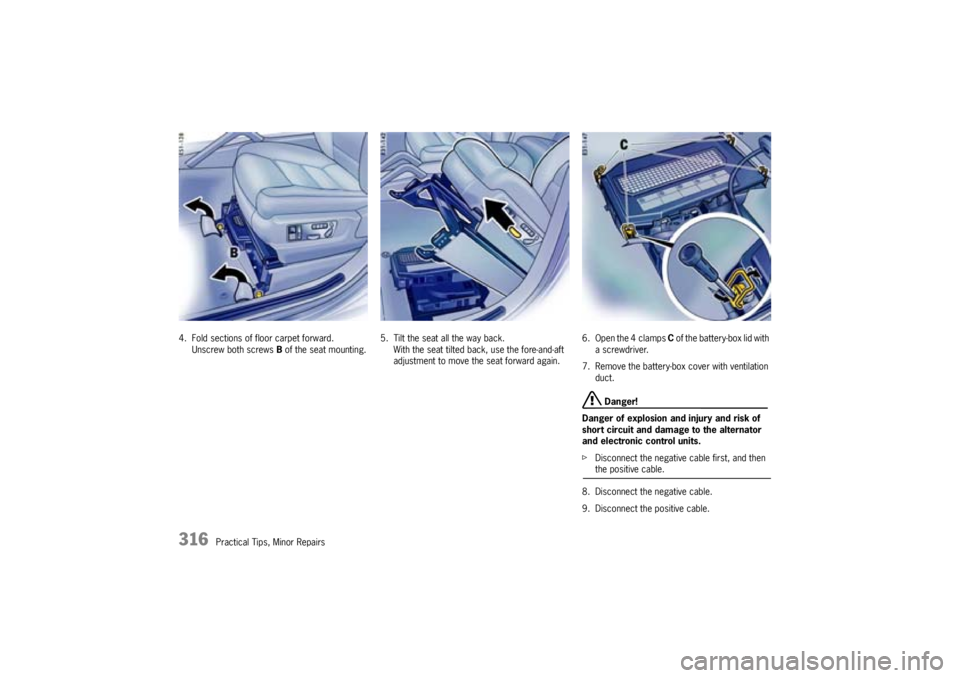
316
Practical Tips, Minor Repairs 4. Fold sections of floor carpet forward.
Unscrew both screws B of the seat mounting.5. Tilt the seat all the way back.
With the seat tilted back, use the fore-and-aft
adjustment to move the seat forward again.6. Open the 4 clamps C of the battery-box lid with
a screwdriver.
7. Remove the battery-box cover with ventilation
duct.
Danger!
Danger of explosion and injury and risk of
short circuit and damage to the alternator
and electronic control units.
fDisconnect the negative cable first, and then the positive cable.
8. Disconnect the negative cable.
9. Disconnect the positive cable.
Page 317 of 369
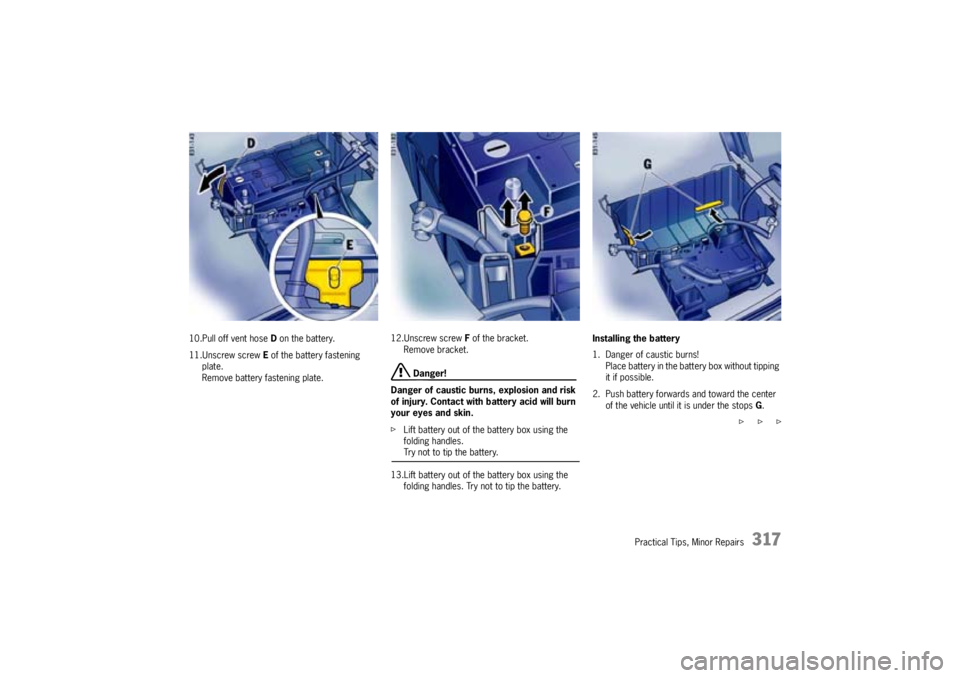
Practical Tips, Minor Repairs
317
10.Pull off vent hose D on the battery.
11.Unscrew screw E of the battery fastening
plate.
Remove battery fastening plate.12.Unscrew screw F of the bracket.
Remove bracket.
Danger!
Danger of caustic burns, explosion and risk
of injury. Contact with battery acid will burn
your eyes and skin.
fLift battery out of the battery box using the
folding handles.Try not to tip the battery.
13.Lift battery out of the battery box using the
folding handles. Try not to tip the battery.Installing the battery
1. Danger of caustic burns!
Place battery in the battery box without tipping
it if possible.
2. Push battery forwards and toward the center
of the vehicle until it is under the stops G.
f f f
Page 318 of 369
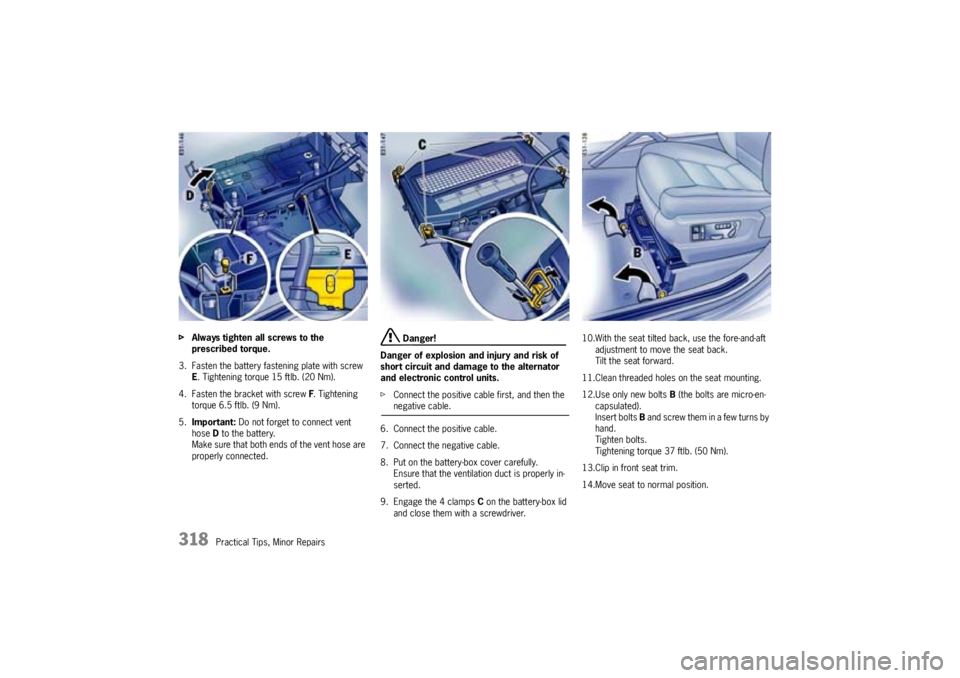
318
Practical Tips, Minor Repairs fAlways tighten all screws to the
prescribed torque.
3. Fasten the battery fastening plate with screw
E. Tightening torque 15 ftlb. (20 Nm).
4. Fasten the bracket with screw F. Tightening
torque 6.5 ftlb. (9 Nm).
5.Important: Do not forget to connect vent
hoseD to the battery.
Make sure that both ends of the vent hose are
properly connected.
Danger!
Danger of explosion and injury and risk of
short circuit and damage to the alternator
and electronic control units.
fConnect the positive cable first, and then the negative cable.
6. Connect the positive cable.
7. Connect the negative cable.
8. Put on the battery-box cover carefully.
Ensure that the ventilation duct is properly in-
serted.
9. Engage the 4 clamps C on the battery-box lid
and close them with a screwdriver.10.With the seat tilted back, use the fore-and-aft
adjustment to move the seat back.
Tilt the seat forward.
11.Clean threaded holes on the seat mounting.
12.Use only new bolts B(the bolts are micro-en-
capsulated).
Insert bolts Band screw them in a few turns by
hand.
Tighten bolts.
Tightening torque 37 ftlb. (50 Nm).
13.Clip in front seat trim.
14.Move seat to normal position.
Page 319 of 369
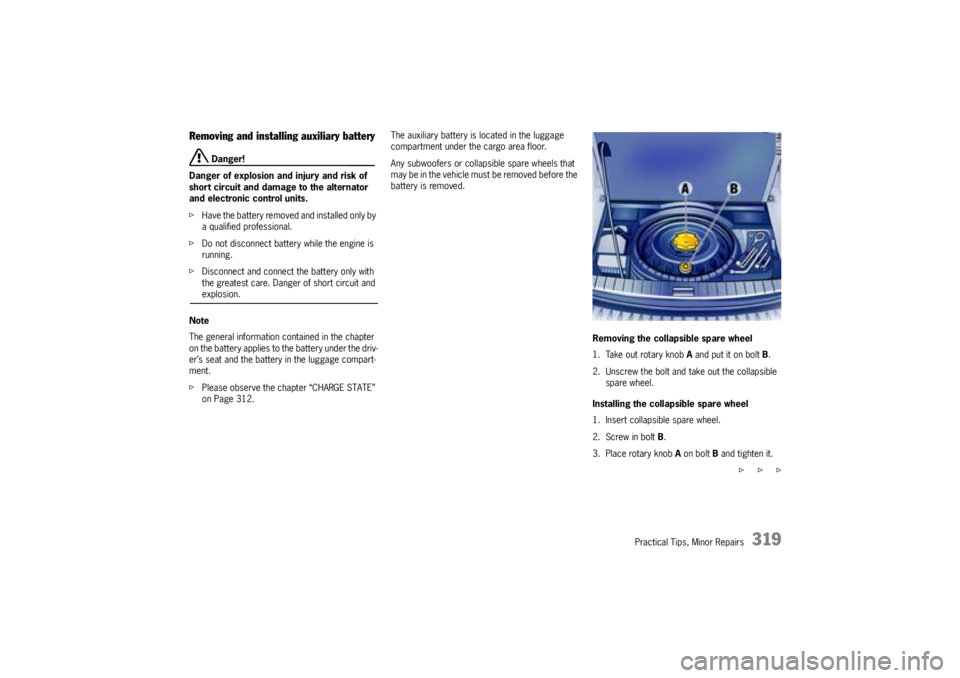
Practical Tips, Minor Repairs
319
Removing and installing auxiliary battery
Danger!
Danger of explosion and injury and risk of
short circuit and damage to the alternator
and electronic control units.
fHave the battery removed and installed only by
a qualified professional.
fDo not disconnect battery while the engine is
running.
fDisconnect and connect the battery only with
the greatest care. Danger of short circuit and explosion.
Note
The general information contained in the chapter
on the battery applies to the battery under the driv-
er’s seat and the battery in the luggage compart-
ment.
fPlease observe the chapter “CHARGE STATE”
on Page 312.The auxiliary battery is located in the luggage
compartment under the cargo area floor.
Any subwoofers or collapsible spare wheels that
may be in the vehicle must be removed before the
battery is removed.
Removing the collapsible spare wheel
1. Take out rotary knob A and put it on bolt B.
2. Unscrew the bolt and take out the collapsible
spare wheel.
Installing the collapsible spare wheel
1. Insert collapsible spare wheel.
2. Screw in bolt B.
3. Place rotary knob A on bolt B and tighten it.
f f f
Page 320 of 369
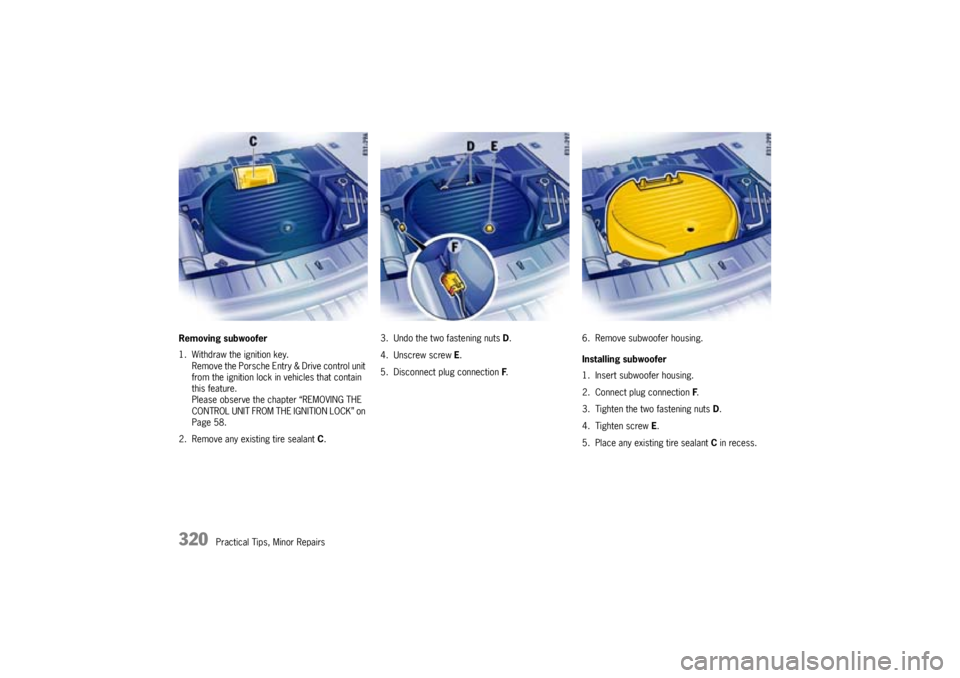
320
Practical Tips, Minor Repairs Removing subwoofer
1. Withdraw the ignition key.
Remove the Porsche Entry & Drive control unit
from the ignition lock in vehicles that contain
this feature.
Please observe the chapter “REMOVING THE
CONTROL UNIT FROM THE IGNITION LOCK” on
Page 58.
2. Remove any existing tire sealant C.3. Undo the two fastening nuts D.
4. Unscrew screw E.
5. Disconnect plug connection F.6. Remove subwoofer housing.
Installing subwoofer
1. Insert subwoofer housing.
2. Connect plug connection F.
3. Tighten the two fastening nuts D.
4. Tighten screw E.
5. Place any existing tire sealant C in recess.